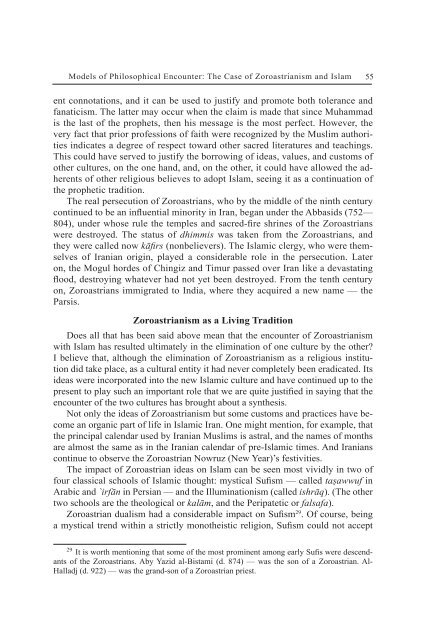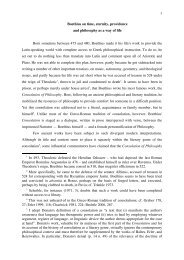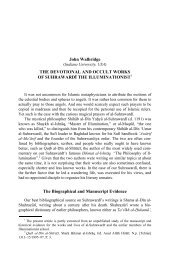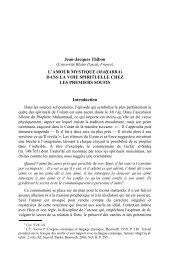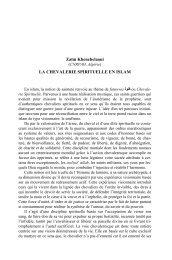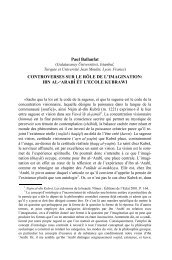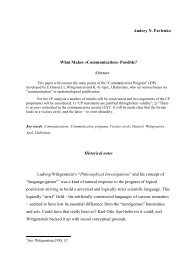Marietta Stepanyants (Institute of Philosophy, Russian Academy of ...
Marietta Stepanyants (Institute of Philosophy, Russian Academy of ...
Marietta Stepanyants (Institute of Philosophy, Russian Academy of ...
You also want an ePaper? Increase the reach of your titles
YUMPU automatically turns print PDFs into web optimized ePapers that Google loves.
Models <strong>of</strong> Philosophical Encounter: The Case <strong>of</strong> Zoroastrianism and Islam 55<br />
ent connotations, and it can be used to justify and promote both tolerance and<br />
fanaticism. The latter may occur when the claim is made that since Muhammad<br />
is the last <strong>of</strong> the prophets, then his message is the most perfect. However, the<br />
very fact that prior pr<strong>of</strong>essions <strong>of</strong> faith were recognized by the Muslim authorities<br />
indicates a degree <strong>of</strong> respect toward other sacred literatures and teachings.<br />
This could have served to justify the borrowing <strong>of</strong> ideas, values, and customs <strong>of</strong><br />
other cultures, on the one hand, and, on the other, it could have allowed the adherents<br />
<strong>of</strong> other religious believes to adopt Islam, seeing it as a continuation <strong>of</strong><br />
the prophetic tradition.<br />
The real persecution <strong>of</strong> Zoroastrians, who by the middle <strong>of</strong> the ninth century<br />
continued to be an influential minority in Iran, began under the Abbasids (752—<br />
804), under whose rule the temples and sacred-fire shrines <strong>of</strong> the Zoroastrians<br />
were destroyed. The status <strong>of</strong> dhimmis was taken from the Zoroastrians, and<br />
they were called now kāfirs (nonbelievers). The Islamic clergy, who were themselves<br />
<strong>of</strong> Iranian origin, played a considerable role in the persecution. Later<br />
on, the Mogul hordes <strong>of</strong> Chingiz and Timur passed over Iran like a devastating<br />
flood, destroying whatever had not yet been destroyed. From the tenth century<br />
on, Zoroastrians immigrated to India, where they acquired a new name — the<br />
Parsis.<br />
Zoroastrianism as a Living Tradition<br />
Does all that has been said above mean that the encounter <strong>of</strong> Zoroastrianism<br />
with Islam has resulted ultimately in the elimination <strong>of</strong> one culture by the other?<br />
I believe that, although the elimination <strong>of</strong> Zoroastrianism as a religious institution<br />
did take place, as a cultural entity it had never completely been eradicated. Its<br />
ideas were incorporated into the new Islamic culture and have continued up to the<br />
present to play such an important role that we are quite justified in saying that the<br />
encounter <strong>of</strong> the two cultures has brought about a synthesis.<br />
Not only the ideas <strong>of</strong> Zoroastrianism but some customs and practices have become<br />
an organic part <strong>of</strong> life in Islamic Iran. One might mention, for example, that<br />
the principal calendar used by Iranian Muslims is astral, and the names <strong>of</strong> months<br />
are almost the same as in the Iranian calendar <strong>of</strong> pre-Islamic times. And Iranians<br />
continue to observe the Zoroastrian Nowruz (New Year)’s festivities.<br />
The impact <strong>of</strong> Zoroastrian ideas on Islam can be seen most vividly in two <strong>of</strong><br />
four classical schools <strong>of</strong> Islamic thought: mystical Sufism — called tasawwuf in<br />
Arabic and `irfān in Persian — and the Illuminationism (called ishrāq). (The other<br />
two schools are the theological or kalām, and the Peripatetic or falsafa).<br />
Zoroastrian dualism had a considerable impact on Sufism29 . Of course, being<br />
a mystical trend within a strictly monotheistic religion, Sufism could not accept<br />
29 It is worth mentioning that some <strong>of</strong> the most prominent among early Sufis were descendants<br />
<strong>of</strong> the Zoroastrians. Aby Yazid al-Bistami (d. 874) — was the son <strong>of</strong> a Zoroastrian. Al-<br />
Halladj (d. 922) — was the grand-son <strong>of</strong> a Zoroastrian priest.


